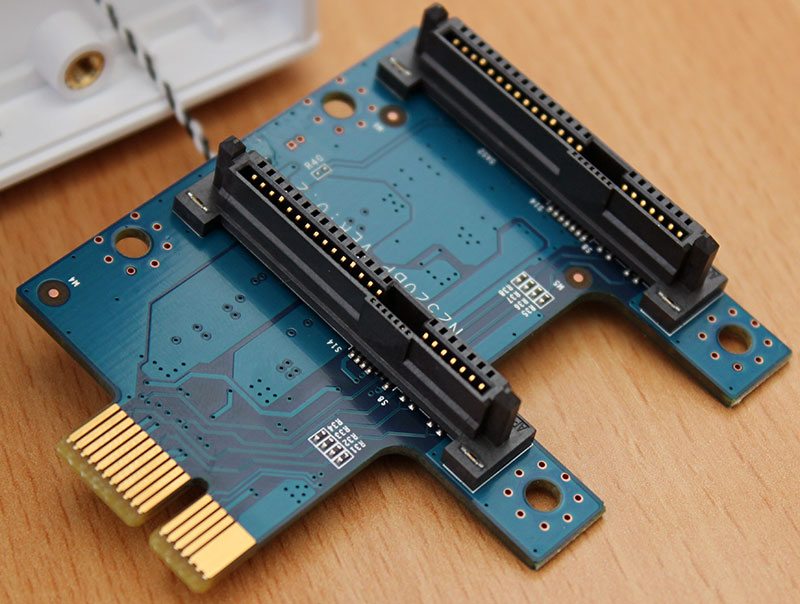Thecus N2560 2-Bay NAS Review
Chris Hadley / 11 years ago
A Closer Look
As I saw recently when I looked at the DS213j from Synology, white is quickly becoming a popular colour for entry-level NAS systems as it blends in to a home environment a lot easier than the black systems that we are used to seeing whilst also being a more aesthetically pleasing to the eye. The N2560 that I’ll be diving in to today is very similar to the recently launched N2520 which we got a hands on look at earlier in the year at CeBIT in Germany. Over the N2520, the N2560 offers up double the amount of memory, with 2GB of DDR3 RAM inside and the Intel CE5315 SoC which runs at 1.2GHz has been replaced with a slightly faster CE5335 1.6GHz SoC to give it a bit more power. Aside these two hardware alterations, the two systems are otherwise identical in appearance and other hardware / software features.

Looking more closely at the front of the NAS, the first thing that is noticeable is the lack of an LCD display that we’re used to seeing on Thecus systems. Like a number of other lower end systems that Thecus have to offer, the N2560 has no need for a display and if one was incorporated then the costs would quickly rise. Instead of a screen there is simple a set of five LEDs the indicated drive and LAN activity, system status and notification. Below the LEDs is a button for the one-touch USB to NAS copy feature, the power button with incorporated LED and a USB3.0 port.
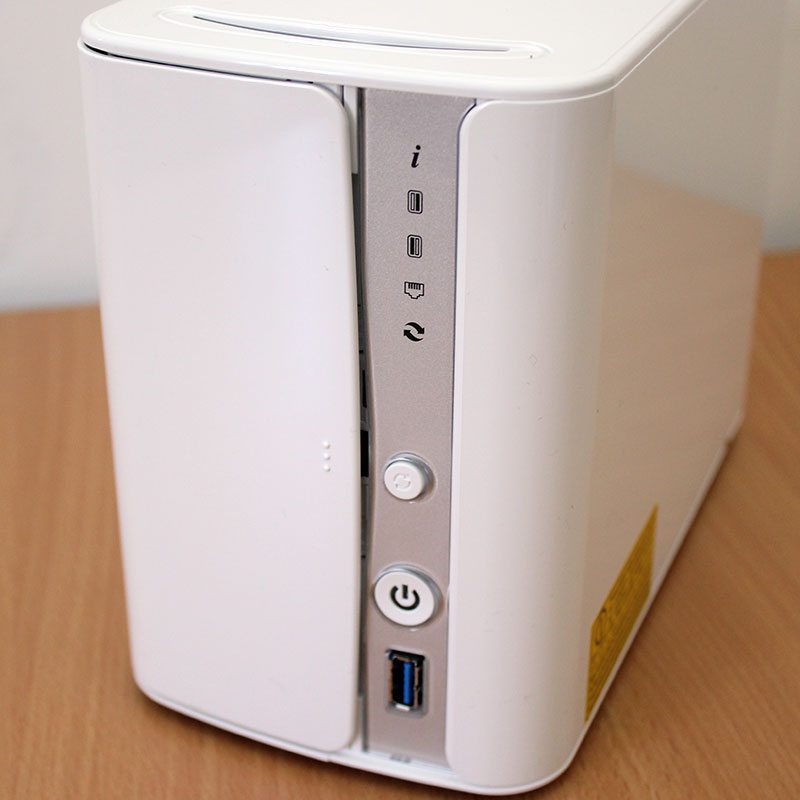
To the left of the LEDs and buttons is a white door that opens via a push lock clip, to reveal the two drive bays that reside behind. This simple design is one of the few that gives the N2560 its user friendliness and toll-free capabilities with there no need for individual drive tray as seen on higher spec models of NAS.

Looking in to the drive bay area on its side, we can see the SATA power and data headers to the right (bottom of the NAS) and to the left (top when standing up) is a pair of spring-loaded arms that push each of the drives forward when the latch at the front of the system is released.

One of the cool things that I like about the N2520/60 is the illuminated Thecus logo that is found on the left hand side of the case. The branding illuminates and flashes in co-ordination with the status LED on the front of the system but for the most part will remain static.
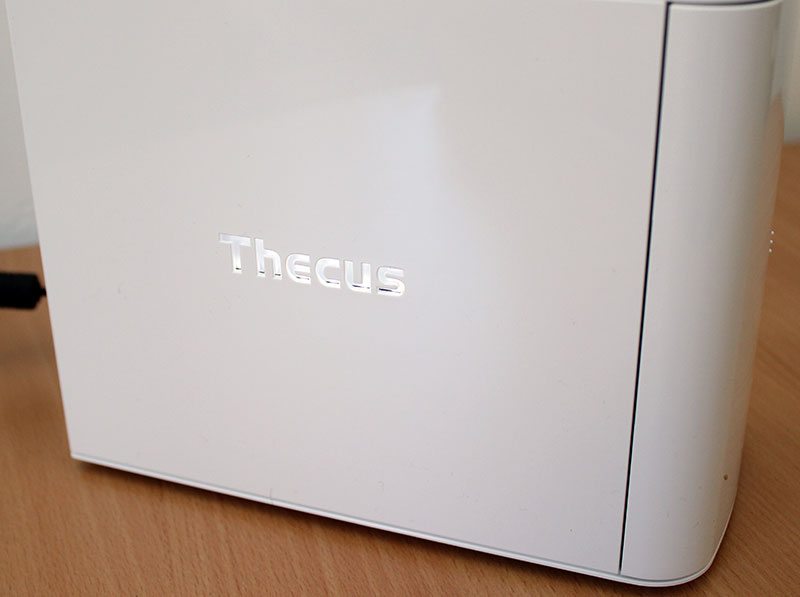
Moving round to the back of the system, there are only a few connections to be found below the 92mm <20dB fan that keeps the system cool. These consist of a pair of USB2.0 ports, Gigabit LAN, S/PDIF optical output for audio and HDMI for media centre functions via XMBC, DC power jack, reset button and a Kensington lock.

On the top of the casing is a small vent that allows air to flow through to keep the system cool. This vent also adds a little bit of style to the top of what is quite a plain and refined looking system.

As seen before, the N2560 comes with no drive trays, but instead has two pairs of drive rails that clip onto either side of a hard drive so that it can slide in and out of the system and latch in place. The rails are very easy to clip on and are secured with three little plastic tabs that push into the three screw holes found on each side of a hard drive.

Once the rails are fitted, the drives easily slide into the bay and lock into place with a latch at the bottom of each bay. Pushing this latch down then allows the drive to be pushed back forward by the arm that sits at the back of each bay.

Whilst the outside is clean and refined in design, we really want to see what is inside that gives the N2560 (and the N2520 for that matter) its power. The N2560 has a rather compact PCB design which helps to keep the overall costs down along with the approach of only including what is going to be needed – no unnecessary extras here.
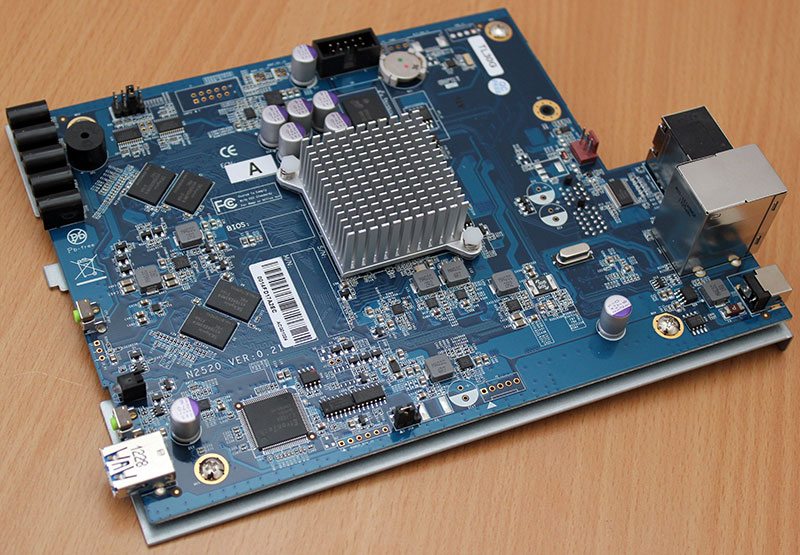
Lying at the heart of the board is the CPU, but what is special with this unit is the inclusion of Intel’s new SoC, making this (and the N2520) the worlds first NAS powered by a SoC.

The SoC we find here is the CE5335 Atom 1.6GHz dual core model. This is one of the two-part that differentiates this unit apart from the N2520 which has a 1.2GHz CE3515 model instead. The reason for the SoC is actually rather simple. Over a CPU, the SoC also incorporates a GPU which for the N2560 and N2520 is important as they both offer media streaming services through the XMBC media centre front end via HDMI.

Further round on the PCB we find another IC of interest. This particular chip from EtronTech is the EJ168A and it takes care of the USB 3.0 bus for the front panel USB3.0 port.

Back down by the SoC is another small IC, this time from Micron. This 2GB JW865 e-MMC NAND flash is home to the systems operating system and is a major alteration from the SATA DOM units that we have seen in the past.

The last IC’s of interest to us lie towards the front of the PCB and are arranged in two banks of two chips. This is the systems RAM – courtesy of SK Hynix.

Looking a little closer, the H5TQ4G63MFA chips that we see give the system 2GB of DDR3 1600MHz DRAM between them. Whilst each IC is capable of giving up to 4GB in their own right, each one has a reduced memory bank which in turn reduces the overall manufacturing costs and therefore a lower cost to the end-user.

Storage aside and looking back at the front panel controls, we can see more clearly the two buttons for power and rebooting the NAS with a small LED to the left of one of the buttons which indicates system boot status like the Thecus logo on the side of the system.

On the other end of the front edge is a line of white LEDs which shine through the front panel for drive, LAN and system status indication. Just behind these we can see a speaker which sounds when the NAS is ready to use or is powering down.

On the back of the board, the Gigabit LAN is handled by a Realtek RTL8211E controller and just underneath the HDMI port we can see a small white button which resets the NAS back to factory settings.
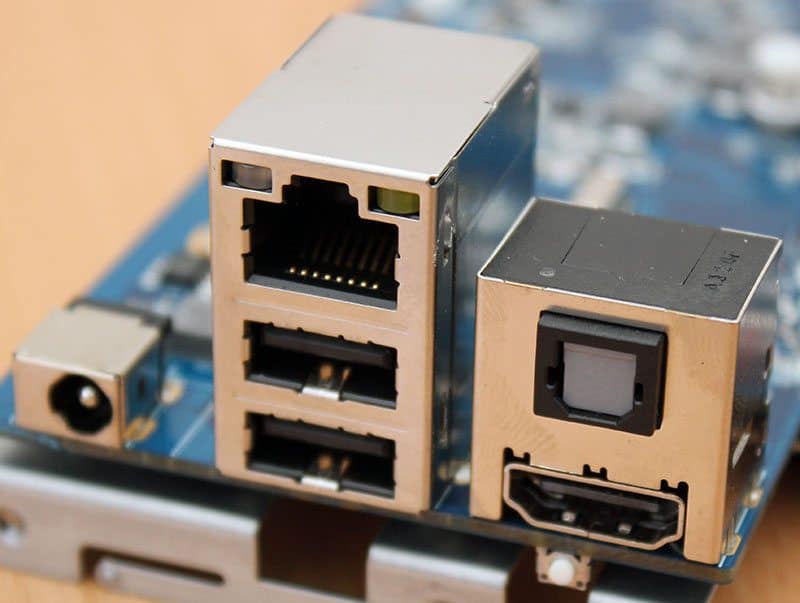
Placing the motherboard aside, there is a smaller daughter card inside the system that connects via a PCIe x1 lane on the rear of the motherboard providing both SATA power and DATA links. On the back of the PCB we can just about see a black and white wire which runs up to the LED strip that illuminates the Thecus logo on the side of the system.
